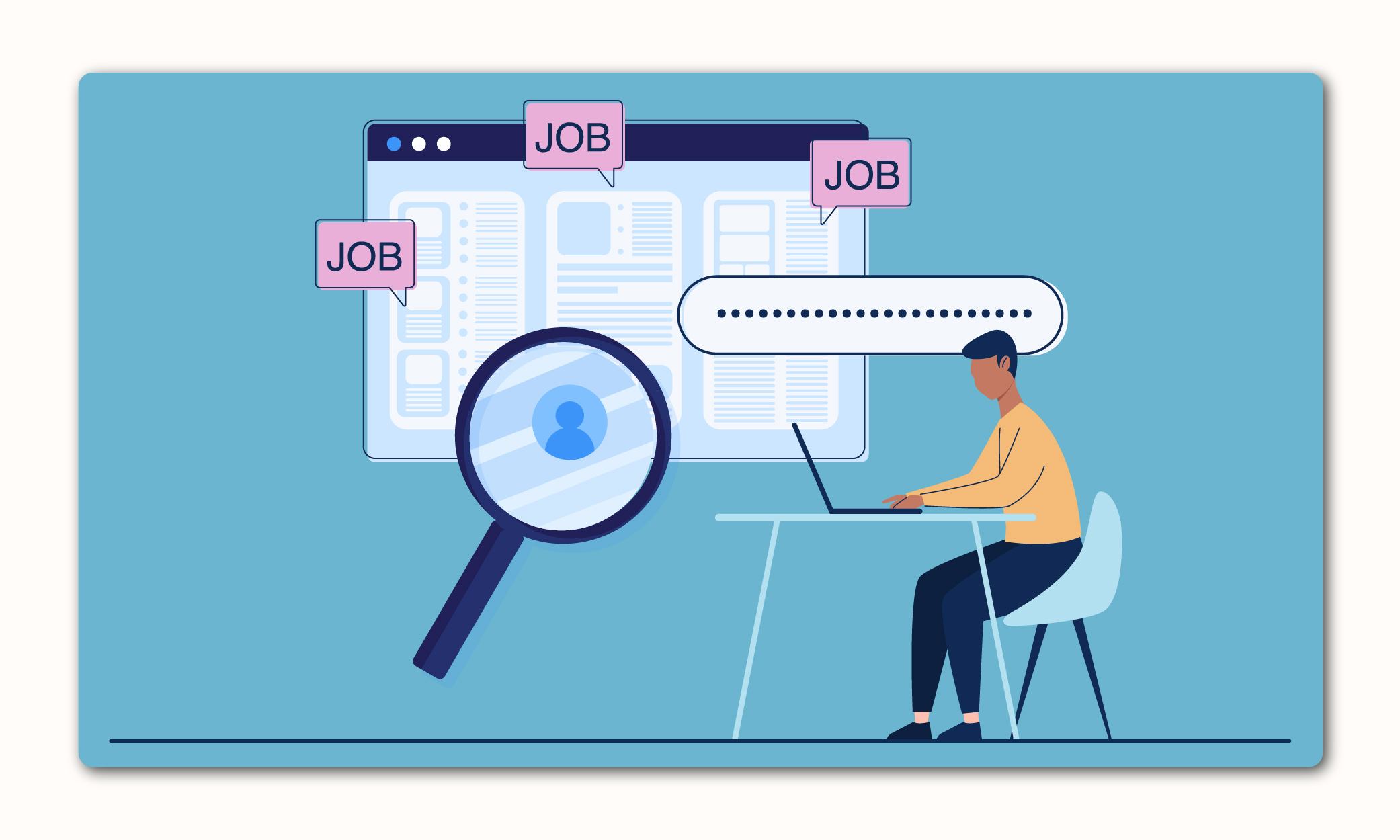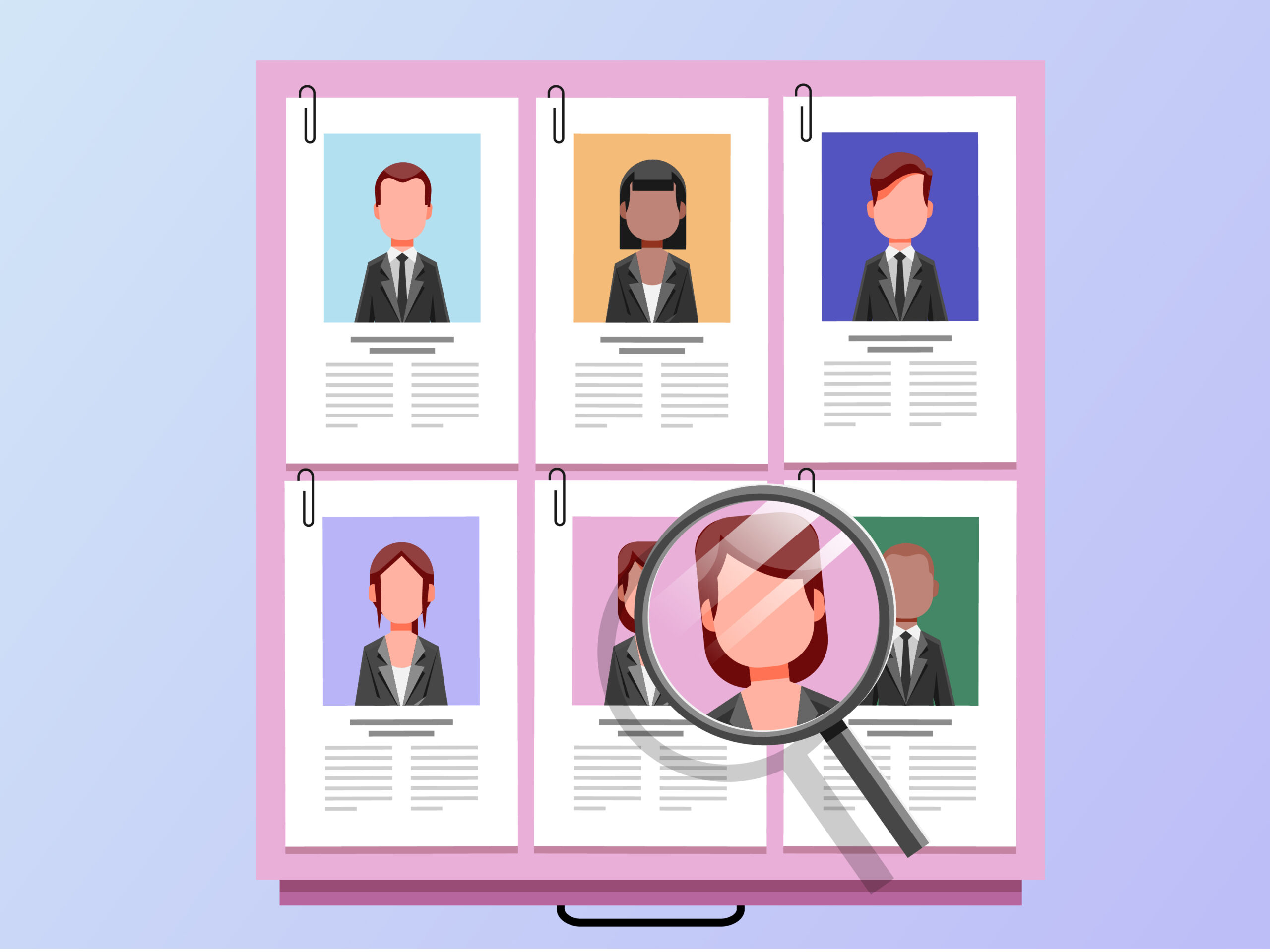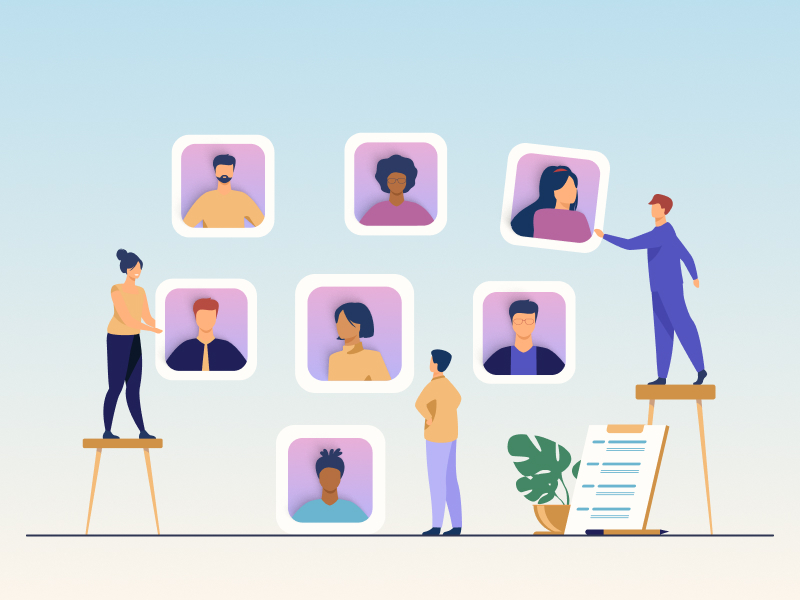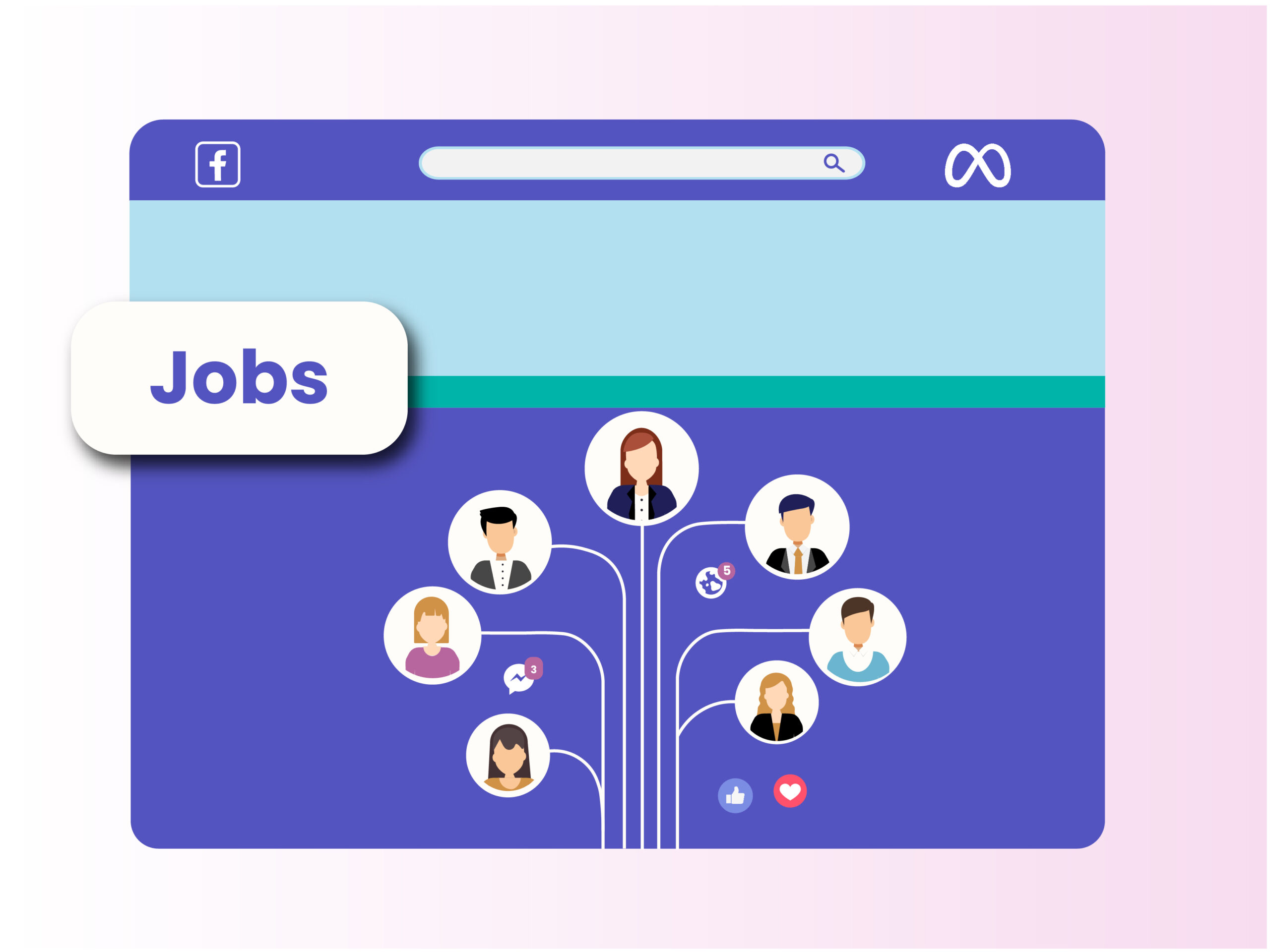What is Candidate Relationship Management?
Employers engage with a lot of candidates when hiring for one or more roles. And these interactions can leave a lasting impression on the candidate, whether positive, negative, or neutral.
Candidate relationship management (CRM) systems are used by recruiting teams to establish and maintain relationships with applicants. When it’s done right, this includes respectfully and thoughtfully handling all interactions with a candidate, be it email, text, job advertisement, the interview process, and even onboarding.
Don’t forget: all of these interactions impact the organization’s employer brand, whether the candidate ends up getting hired or not!

Why is Candidate Relationship Management Important?
Candidate relationship management is critical and helps build and maintain strong connections with candidates now and in the future!
Let’s look at the possible scenarios:
- When a candidate converts to an employee: Good candidate relationship management sets the tone for onboarding. A smooth transition leads to higher levels of employee engagement, productivity, and retention in the long run. Plus, a positive candidate experience can turn employees into brand ambassadors, which helps attract more top! Very straightforward.
- When a candidate does not get hired: Well, candidate relationship management is equally important in this case. A positive experience during the recruitment process can leave candidates with a good impression of the organization even if they don’t make the cut. This may mean they reapply for future positions or recommend the organization to their contacts. This expands your talent pool, as well helps that oh-so-important employer brand.
In a nutshell, good candidate relationship management helps recruiting teams find the right people for the job quickly and more efficiently, contributes to employer branding, and positions the company as a good place to work. What a trifecta!
Benefits of Candidate Relationship Management
- Early access to top talent: Consistent messaging helps build trust and rapport, helping recruiters understand candidate needs better. By staying in touch over time, recruiters can offer more tailored opportunities and candidates will be more likely to consider them in the future. This gives employers a competitive edge!
- The chance to build a positive employer brand: Candidates often research a company’s reputation before applying. By engaging with candidates and showcasing your company culture, you can attract top talent who already align with your values.
- Enhanced candidate experience: Personalized and thoughtful communication goes a long way in building a positive impression. Candidates who experience a smooth recruitment process are more likely to convert. Even if not hired, the chances of them coming back in the future are higher.
- Insight into the recruitment cycle: How about invaluable insights when it comes to where candidates drop out of your recruitment process and where they react positively? This information can help you optimize your strategy and improve engagement in the future.
- Nurture and recognize talent for future: Building relationships with candidates, even if they are not selected for a current role, can pave the way. This is a way to highlight how much you value their skills and shows them that you are willing to invest in their professional development.
- Diverse and inclusive talent pool: By analyzing candidate demographics, you can ensure your talent pipeline is diverse and inclusive. The result? Well, hopefully a more innovative and productive workforce!
- Cost-effective hiring: By nurturing relationships with candidates over time, you can reduce the need for external sources – recruitment agencies, costly advertising. etc… All thanks to the fact that you have a pool of engaged candidates.
- Quick hiring: Long-term vacancies can lead to project delays and/or additional workload being shifted to existing employees. With an already active talent pool, you significantly reduce the time it takes to fill vacancies. Agility leads to increased productivity!
- Stronger employee engagement: Candidates who have a positive experience during the recruitment process are more likely to be engaged employees if hired. This leads to higher retention rates.
Make sure you\'re prepped for success with our 2024 ultimate guide to diversity hiring.
Is DE&I a Priority for You in 2024?
What is a Recruitment CRM?
Now that we’ve emphasized the importance of candidate relationship management, the next question is how do we achieve it. Is it all manual work? Thankfully, the answer is no.
Enter a recruitment CRM, the tool that makes effective candidate management a reality.
What does this tool do? Well, think of it as your dynamic talent database. It’s where you keep track of all candidates – the ones actively seeking jobs and those who’ve applied in the past.
But this tool is much more than just a storage space – or it should be! With a good recruitment CRM, you can do some pretty cool stuff to improve your recruitment process. For one, you can run marketing campaigns to keep candidates engaged, highlight previous applicants who might be a good fit for new roles, and even automate personalized messages to keep in touch with potential hires. Plus, you’ll get notified when candidates show interest, so you can move them along the hiring process without a miss.
It’s important to note that a recruitment CRM is different from an applicant tracking system (ATS) and a customer relationship management (CRM) tool.
Recruitment CRMs vs Applicant Tracking Systems vs Generic CRMs
Recruitment CRM vs ATS
A recruitment CRM is a specialized tool designed to manage candidate relationships and the recruitment process. It offers features tailored to recruiters’ needs, like tracking candidate interactions, managing talent pools, and nurturing relationships.
An applicant tracking system (ATS) is designed to streamline the application process by organizing and tracking candidate information. It is used by HR teams as a central database for resumes and other application materials to manage hiring. Some applicant tracking system platforms also offer additional features, such as posting job openings on multiple platforms and using AI to match candidates with suitable roles.
The ATS was designed for an employer-driven environment where companies would post job openings and wait for applications to come in. But, in today’s candidate-driven market, recruitment practices have evolved and the traditional ATS model may not be as effective.
Recruitment CRM vs Generic CRM
As we know, a recruitment CRM is specifically designed to manage candidate relationships and the recruitment process. Generic customer relationship management (CRM) systems are designed for managing relationships with customers. Unfortunately, these systems lack the specialized features needed for recruitment.
For recruiters, the choice between a recruitment CRM and a generic CRM depends on the need. If recruiting is a significant part of your role and you need features like candidate tracking and talent pool management, a recruitment CRM should be the choice. And, if you primarily need a tool for managing customer relationships and want some very basic candidate management features, a generic CRM may have you covered.
Make your candidate database work for you and create experiences that convert. Meet MOJO Talent Engage CRM.Struggling to Build Meaningful Relationships with Candidates, Across Channels?
The Candidate Relationship Management Process
As recruiters, it’s important to have a structured approach to managing candidate relationships. Let’s explore the four steps to building and maintaining connections and understand how they contribute to a successful recruitment strategy.
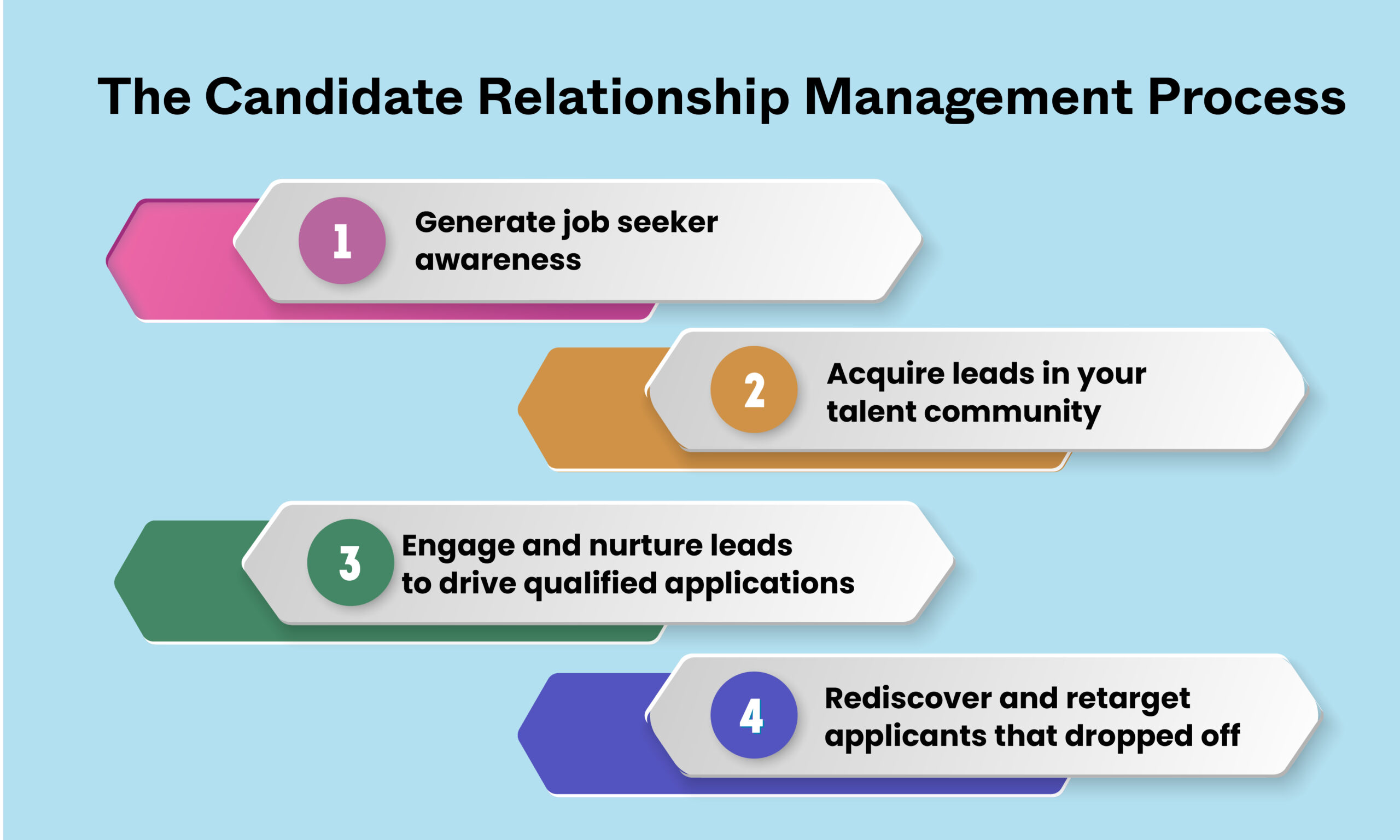
1. Generate job seeker awareness
Start by creating awareness about your brand and organization among job seekers. This can be done through various channels such as social media, job boards, and career fairs. For example, you can share engaging content about your company culture and values to attract potential candidates and make them aware of job opps.
2. Acquire leads in your talent community
Once you’ve generated awareness, focus on acquiring leads for your talent community. Encourage interested candidates to join your talent network by subscribing to your newsletter or following your social media pages. This way, you can build a pool of potential candidates who are interested in your organization and open to future job opportunities.
3. Engage and nurture leads to drive qualified applications
Engage with your talent community regularly to keep them interested and informed. Share relevant content, such as job openings, company updates, and industry news, to nurture these leads. By building a relationship with them over time, you can increase the likelihood of them applying for a job when the right opportunity arises.
4. Rediscover and retarget applicants that dropped off
Finally, don’t forget about candidates who may have dropped off during the application process or were not selected for a role. Keep the door open for them by maintaining a positive relationship. For example, you can invite them to join your talent community or inform them about future job openings that match their skills and experience. These “silver medalists” could be valuable candidates for future roles, so it’s important to stay connected with them.
To effectively manage these steps while recruiting in large numbers, you need the right tool – a recruitment CRM.
Features of a Recruitment CRM
The CRM process can be a breeze with the right tool, making each and every candidate communication relevant and personalized.
Check out some of the innovative features offered by recruitment CRMs:
- Candidate profile creation: With a recruitment CRM, you can create detailed profiles for each candidate. These profiles include not just basic information like contact details and work experience, but also their interests, skills, and preferences. All this data gets collected from resumes and your interactions with them – emails, offer letters, assessments, and more.
- Resume parser: Using this feature, a CRM sifts through piles of resumes, extracting key details such as work experience, skills, and education. Recruiters can use this tool to quickly shortlist the most relevant candidates, saving time and streamlining the hiring process. And time is money!
- Candidate-to-job matching: This feature uses advanced algorithms to match candidates with job openings based on their skills, experience, and preferences. It helps recruiters quickly identify the most suitable candidates for each job, increasing the chances of making successful hires, with a quickness.
- Messaging sequences: This feature allows you to set up automated email and SMS sequences to engage with candidates at different stages of the recruitment process. For example, you can create a sequence to send a welcome email to new candidates, followed by reminders for upcoming interviews and follow-ups after interviews. This helps you stay in touch with candidates and keep them engaged without manual effort.
- Automated workflows: With this feature, the tool can create automated processes for repetitive tasks, like sending follow-up emails or scheduling interviews, all personalized. Automated workflows save time and ensure consistency.
- Ratings: This feature allows stakeholders to evaluate candidates based on their skills, experience, and fit for the organization. By assigning ratings, you can easily identify top candidates and prioritize them for current or future job openings.
- Talent segment creation: The CRM is able to create talent segments for different roles and departments using this feature. These separate groups help in organizing and managing candidates efficiently.
- Integration with applicant tracking systems: This feature allows the CRM to sync with your current ATS, ensuring a cohesive candidate journey. By leveraging existing data and bidirectional integration, recruiters can personalize communication and engage with candidates at the right time with the right message. This ensures that candidates receive relevant updates and offers, enhancing their overall experience.
- Reporting analytics: Keep an eye on your CRM campaign’s progress. A good recruitment CRM will let you know which sourcing channels are rockin’, how many employee referrals are pouring in, your conversion rates, and more. Plus, it’ll allow you to tweak your report and download it in a snap, whether you prefer CSV or PDF.
- Cross-device functionality: Cross-device functionality in a recruitment CRM allows you to seamlessly access the tool from various devices, such as computers, tablets, and smartphones. This flexibility is really useful when you’re away from your workstation.
Best Practices for Candidate Relationship Management
Whether you’re dealing with a large number of candidates using a tool or manually handling a handful of relationships, the important thing is to remember you’re dealing with human beings. Each interaction, no matter how automated, should reflect empathy and understanding.
Therefore, all best practices emphasize one key principle – the human connection.
- Segment your talent pool: Segmenting candidates is like organizing a toolbox – it helps you find the right tool for the job faster. By categorizing candidates based on skills, experience, and job preferences, you can communicate more effectively and match them to the perfect role when needed.
- Personalize your interactions: All of us like to be addressed by our names, and the same applies to your talent pool. Personalize communications by using candidates names and mentioning specific details from their profile or previous interactions. This shows that you value them as individuals and are genuinely interested in their candidacy.
- Make sure your brand shines through: Ensure that your employer brand is well represented in all interactions with candidates. This includes showcasing your company’s values, culture, and unique selling points.
- Acknowledge every candidate: Acknowledge and appreciate every candidate who interacts with your organization, whether they’re successful or not. A simple thank-you email or personalized message can leave a great impression and encourage candidates to consider you in the future.
- Create sequences across multiple communication channels: Use a mix of communication channels like email, messages, and phone calls. For example, send a follow up email after an interview, then reach out over the phone for next steps. This approach keeps you connected and ensures your messages don’t go unnoticed.
- Automate everything you can: Routine tasks like email responses, appointment scheduling, and data entry should be automated to save time and focus on more strategic aspects. This increases recruiters’ efficiency and also ensures that no important details or follow ups are missed.
- Analyze engagement metrics to understand what works: Metrics such as open rates, click-through rates, and response rates should be analyzed frequently to understand which strategies are working. For example, if you notice that candidates respond more to emails sent on a certain day of the week or at a specific time, adjust your communication schedule accordingly.
- Don’t forget about your silver medalists: While it’s natural to focus on hiring the best candidate for a role, don’t overlook other strong contenders. These “silver medalists” may not have been the perfect fit for one position, but they could be ideal for another role in the future. By maintaining a positive relationship with these candidates, you keep the door open for future opportunities.
- Train and educate users: Provide initial and ongoing training to your team – make sure they know how to use the CRM system and are familiar with best practices for candidate engagement. Often, the initial team is trained, but as team members leave, get promoted, or new users join, information is lost. Regular training ensures that your team is equipped with the necessary skills and knowledge to make the most out of the CRM system and build strong relationships with candidates.
Conclusion
A recruitment CRM is key – it saves time and money. Having a pool of pre-screened candidates puts you in control of recruiting, ensuring you find the best fit for the job. Good candidate relationship management not only saves time and money, it helps build a strong employer brand that will benefit you in the long run – better talent attraction, stronger retention, and eventually fewer open positions to fill.
The message is simple and clear. If you haven’t invested in a recruitment CRM, it’s time to consider making the change.
FAQs
What is a recruitment CRM?
A recruitment CRM is a software solution that helps companies manage and improve their relationships with potential job candidates. It enables recruiters to track candidate interactions, manage communication, and streamline the recruitment process.
How is a recruitment CRM different from a regular CRM?
While a regular CRM focuses on managing customer relationships, a recruitment CRM is specifically designed to manage relationships with potential job candidates. It includes features such as candidate sourcing, pipeline management, and interview scheduling, which are tailored to the needs of recruiters.
How is a recruitment CRM different from an ATS?
An applicant tracking system (ATS) is primarily used to manage the hiring process, from receiving applications to making job offers. A recruitment CRM, on the other hand, focuses on building and maintaining relationships with candidates, even before they apply for a job. It is more proactive in nature, helping recruiters source and engage with potential candidates.
What are the key features of a recruitment CRM?
Key features of a recruitment CRM include candidate profiling, pipeline management, interview scheduling, automated workflows, talent pool creation, ratings, analytics and reporting, and integration with other HR systems.
What is recruiting automation?
Recruiting automation refers to the use of technology to automate repetitive and time-consuming tasks in the recruitment process. This can include automating job postings, screening resumes, scheduling interviews, and sending follow-up emails. By automating these tasks, recruiters can save time and focus on more strategic aspects of their job.
Looking to streamline your recruitment efforts?
- Try our Job Description Optimizer for quick, effective job descriptions.
- Forecast your ad spend with the CPA Calculator.
- Need help choosing vendors? Explore our RFP Templates for expert guidance.
Also read:
